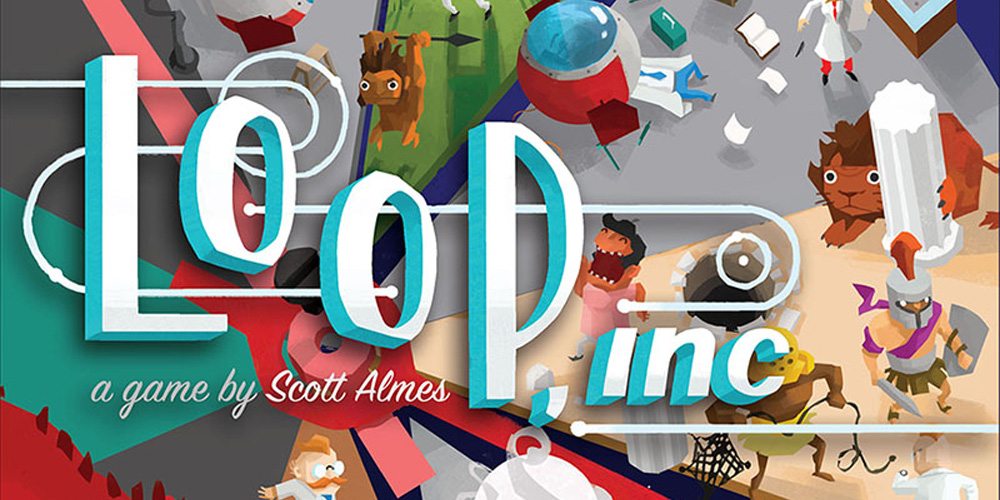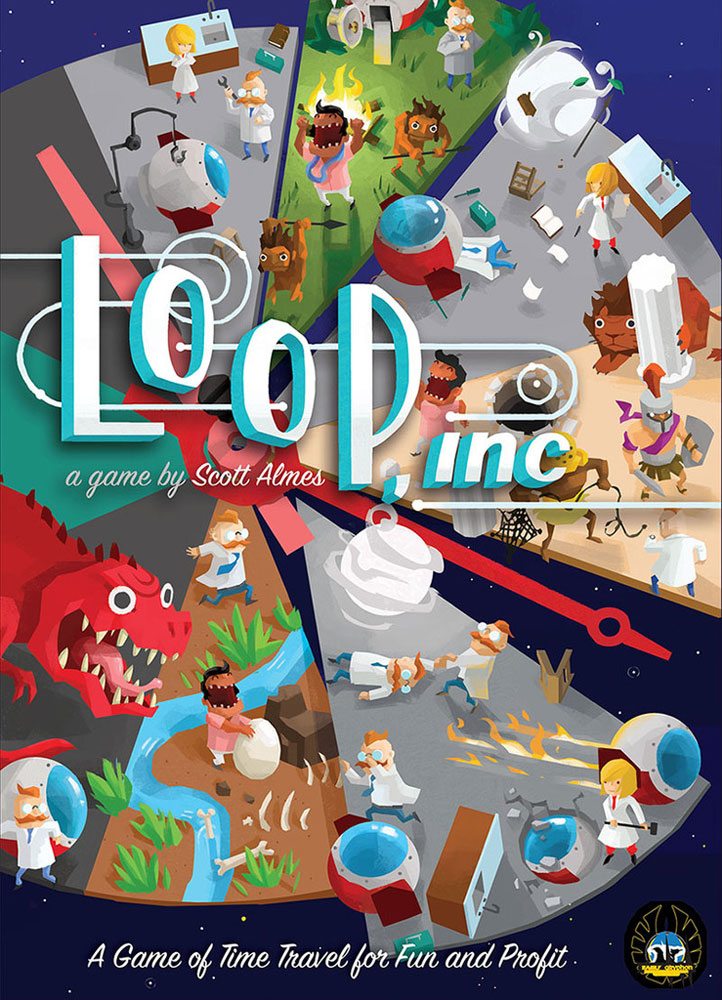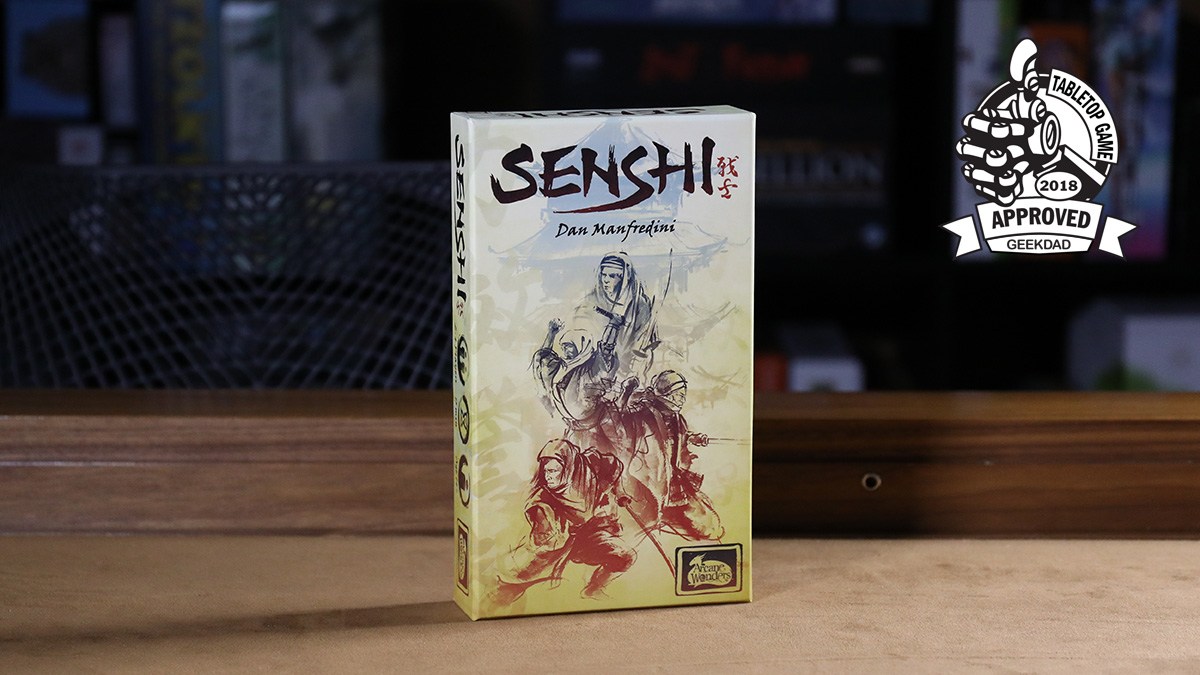In “Reaping the Rewards,” I take a look at the final results of a crowdfunding project. Today’s title: Loop, Inc., a time-travel board game by Scott Almes, published by Eagle-Gryphon Games.
Loop, Inc. was funded a year ago and shipped to backers last fall. For an explanation of the base game rules and my impression, see my original review here.
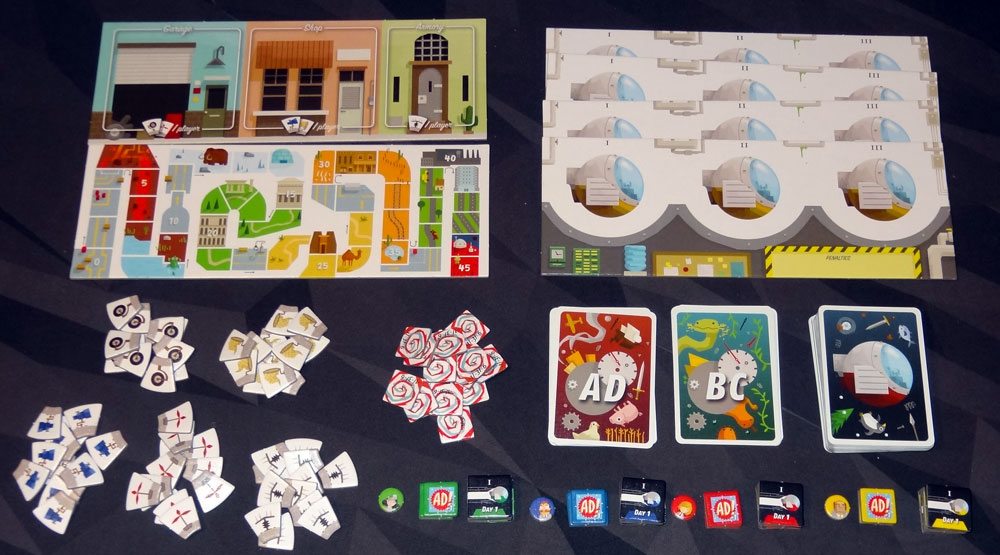
The final component quality, as expected, is quite nice. The cardboard tokens are sturdy, and both the tokens and cards have a linen finish. The game itself did not change much from the prototype to the final product other than the actual component quality and some of the added stretch goals—even all of the artwork by Kwanchai Moriya had already been completed by the time the Kickstarter launched.
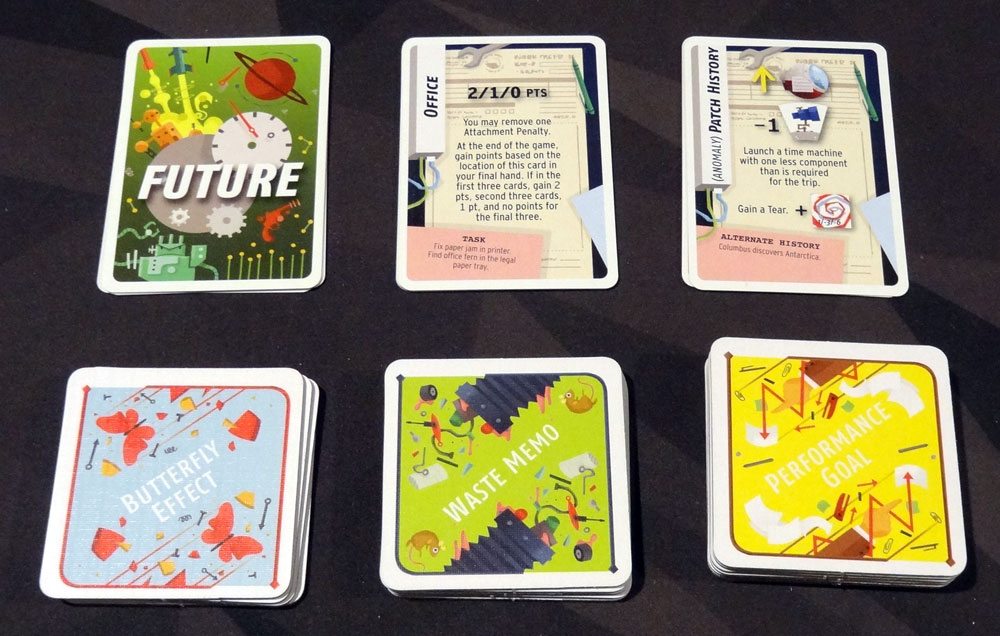
My review copy also included the stretch goal additions, which are not included in the retail version: three mini-expansions called Performance Goals (7 tiles), Waste Memo (5 tiles), and Butterfly Effect (4 tiles). These mini-expansions are square tiles with the mini-expansion title on the back, and different text and graphics on the front. Other stretch goal additions included 5 Future cards for the timeline, 4 additional Anomaly cards, and 5 Office Action cards. I’ll explain how those work later.
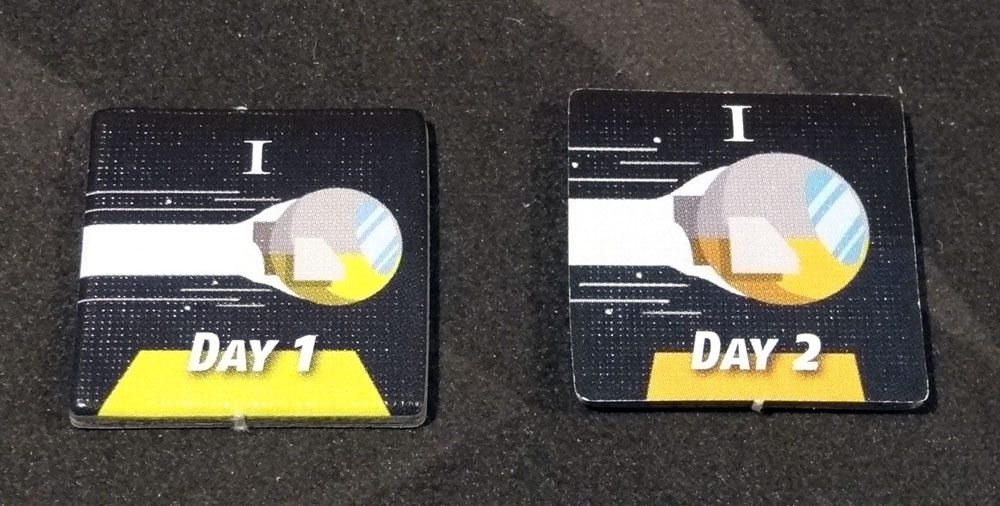
A few minor issues: the fronts and backs of the yellow player’s components don’t quite match in color—the back sides are a little more orange than the front. This is not really all that important because you don’t use the back side for anything in particular; they’re just printed double-sided for fun, as far as I can tell. It’s just weird that it doesn’t match.

For the equipment tiles, though I do wish they were just double-sided and didn’t have the big “-1” printed on the back. Why? Because when you have a big pile of them, you have to flip them all over to sort them out. It doesn’t seem like the “-1” on the back is entirely necessary—particularly once you throw in the “Waste Memo” mini-expansion (explained later).
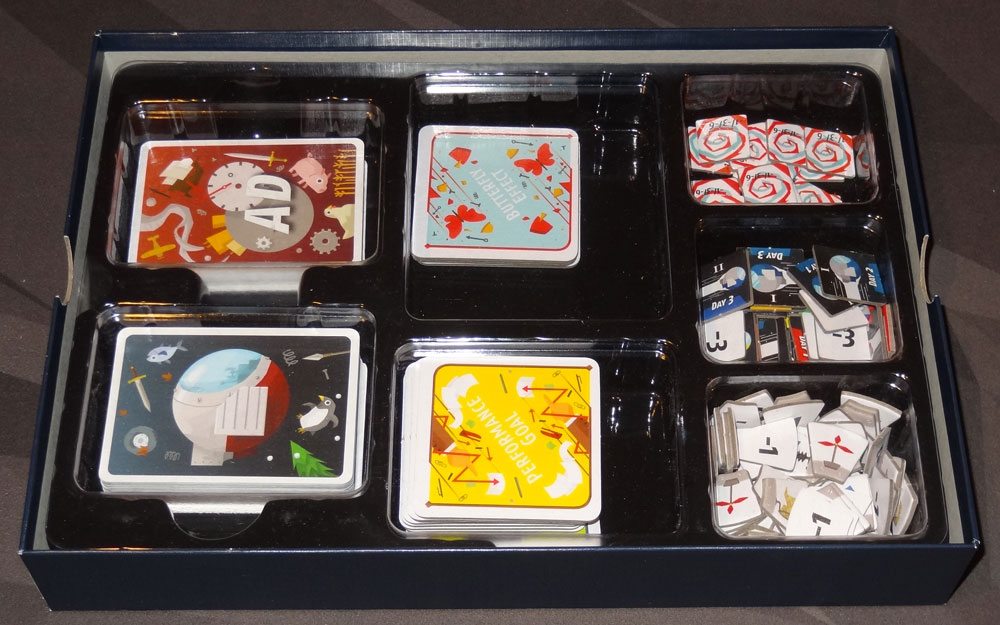
The one complaint I did have about the components is the box: it’s a large rectangular box with a plastic insert (with lid!). But the insert tray doesn’t appear to have been designed for this game. There are three wells for cards—one well would be deep enough to hold all of the cards, but having three lets you divide them up a little—though it’s not clear how you should, because there are more than three types of cards, and if you do divide them up into three piles then they barely fill the wells. There are three small wells and one larger well. The larger well isn’t quite big enough to hold all of the mini-expansion tiles, so I end up using one of the card wells for them. (They don’t fit in the small wells.) Of the small wells, it’s not entirely clear how you should divvy things up. I ended up putting Tear tokens in one, all of the player tokens mixed together in the second, and all of the equipment pieces into the third. Of course, that means when you set up the game you’ll have to sort out all of the player and equipment tokens before you can play.
Finally, the player boards, score board, and component board don’t have specific places—they’re just stacked on top of the lid. It does seem like a little more thought could have been put into the tray to make it work for this game—my guess is that it’s a generic tray of some kind designed for this size box. (I do like the lid, though, which at least prevents components from sliding all over when you pick up the box.)
The basic rules of the game remain the same as what I explained in the original review, so I’ll focus on what the stretch goals add.
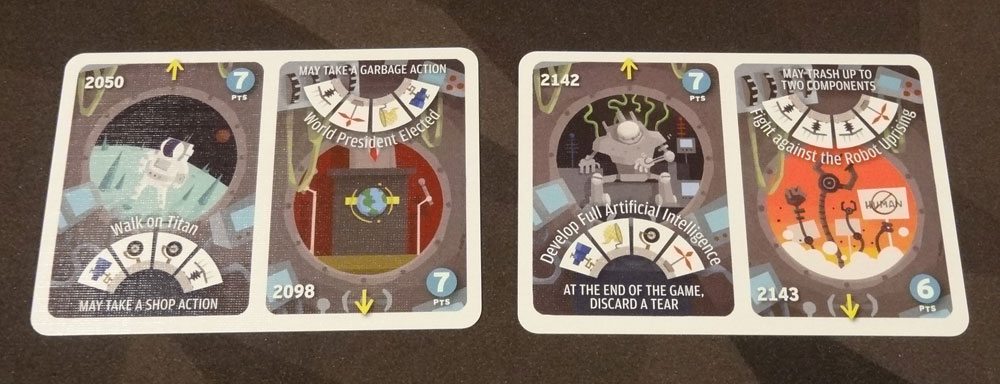
Futures
The Futures cards can be included in the timeline, adding trips to things like “Establish base on Mars” and “Fight Against the Robot Uprising.” These trips don’t give you as many points for the number of equipment items required, but if you take a trip to one of them, you get a special action right away. For instance, you may be able to discard an Ad penalty, trash some components, or get extra components without using your precious actions.

More Anomalies
Four more Anomaly cards were added, just to increase the variety:
- Wormhole: Place two components of the same type on your machines, then gain a Tear.
- Radiation: Launch a ship, then move a component from that ship to an unlaunched ship.
- Alternate Self: Place an action from your hand back into the central play area. This round you’ll draw an additional new card.
- Patch History: Launch a time machine that’s missing one required component. Gain a Tear.

Office
The 5 Office cards are identical other than the flavor text, and they replace the “Trash” action from the base game (which allows you to remove a component from a machine). The Office cards allow you to remove an attachment penalty (traveling with unneeded equipment) but are also worth extra points the earlier in the day you take them.
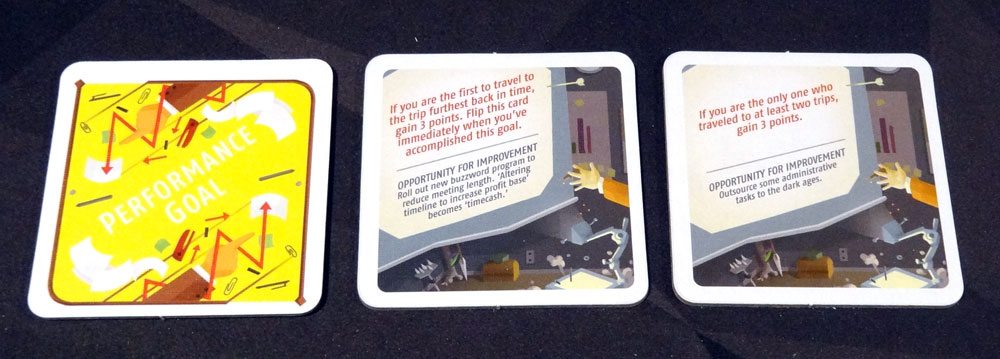
Performance Goals
The Performance Goals are optional secret goals that award bonus points if you accomplish them during the game. Each player gets one and looks at it secretly. Examples include visiting the first and last dates in the timeline, having the most Nets, getting no Tears, or using the most Anomalies.

Waste Memo
The Waste Memo tiles show the five different components and change their penalty values. Usually, when you waste equipment, it’s worth -1 point each. These memos change that, making one component type penalty-free, and two others worth -2 points instead. This mini-expansion tweaks the economy of the game a bit.

Butterfly Effect
The Butterfly Effect tiles are worth -1, 0, 1, and 2 points. They’re shuffled and placed above the trip cards furthest in the past, one per player. If you visit that trip, you flip the card over and place it above another card in the timeline, affecting the score for those trips.
Solo Rules
Finally, there were rules developed for a solitaire variant—you can download them here. The Solo Rules can be played with the retail version—the stretch goal additions are not required.
The premise is that you are competing against Richard Loop Junior, your boss’s son, to succeed Mr. Loop as president of the company. Essentially, you set up the game as if it were a 2-player game, though the number of components changes somewhat, and you use a specific set of action cards. Then, you set up an action deck of cards for Junior.
You take your turns as normal, and Junior takes turns by flipping over cards from his deck, taking components, and then launching to a trip if possible. His advantage is that he doesn’t incur tears if the required components are missing, and has no waste penalty if he takes unnecessary equipment on a trip. His action deck is reshuffled at the end of each “day.” Your goal is to score higher than Junior.
The difficulty can be tweaked by letting Junior go first, setting up his machines with extra equipment at the start, and so on, for a total of 7 difficulty levels.
The Verdict
I’ve played Loop, Inc. a few times since receiving the finished copy, and I still like it a lot—but I also know that it’s not a game I would recommend to everyone. Although each individual action that you make in the game is pretty simple, planning ahead for three days’ worth of actions (and taking into account other players) can be incredibly complex. Some people really love the puzzle aspect of this game and enjoy the challenge, and some just find it frustrating. I will say that most people I’ve played with have an “aha” moment during the game where it all starts to make sense—but the downside is that the “aha” moment often comes during Day 3, when it’s probably too late to salvage your score.
The added stretch goal components aren’t totally necessary to enjoy the game and it’s worth trying even if you can’t get a hold of them, but they do add a lot of fun ways to tweak the game. Of those, I’m probably most likely to use the additional Anomalies all the time, and may throw in some of the others occasionally.
As for the solo rules: I’m not much of a solo gamer in general, but Loop, Inc. is already a more puzzle-like game to begin with. I think the solo rules, in this case, would still preserve a lot of the feel of the full game, though you’ll miss hearing the other players groan as they realize that the shop will be all out of nets by Day 3.
If you like (making your head ache with) time travel, give Loop, Inc. a spin. It’s one of my favorite time-travel games.
